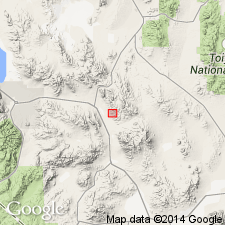
- Usage in publication:
-
- Gabbs formation
- Modifications:
-
- Original reference
- Dominant lithology:
-
- Shale
- Limestone
- AAPG geologic province:
-
- Great Basin
Summary:
Pg. 241-252. Gabbs formation. Purple to black shale and dark-brown to black limestone, 420 feet thick. Conformably underlies Sunrise formation (Lower Jurassic) and conformably overlies Luning formation (Upper Triassic). Fossils from middle, base, and top. [Present in southwestern Nevada, Tonopah and Hawthorne quadrangles. Age is Late Triassic.]
Named from Gabbs Valley Range, where, in New York Canyon area, it is best exposed.
Source: US geologic names lexicon (USGS Bull. 896, p. 788).

- Usage in publication:
-
- Gabbs formation*
- Modifications:
-
- Mapped
- Dominant lithology:
-
- Shale
- Limestone
- AAPG geologic province:
-
- Great Basin
Summary:
Described in Mina quadrangle where it consists of sandy shale and limestone in upper part, brown shaly limestone in middle, and black carbonaceous shale with a few beds of black impure limestone, weathering purple, in lower part. Thickness at type locality 420 feet. Overlies Luning formation; underlies Sunrise formation. [Age is Late Triassic.]
Source: US geologic names lexicon (USGS Bull. 1200, p. 1449).

- Usage in publication:
-
- Gabbs Formation
- Modifications:
-
- Revised
- AAPG geologic province:
-
- Great Basin
Summary:
Gabbs Formation revised in Gabbs Valley Range, west-central Nevada. Is a formation of Volcano Peak Group (new), and includes (ascending) Nun Mine, Mount Hyatt, and Muller Canyon Members (all new). Members replace unnamed members (plus uppermost 10 m unfossiliferous shale) of Muller and Ferguson (1939, GSA Bull., v. 50, no. 10, p. 1573-1624). Type section of Muller Canyon Member is proposed stratotype for the Triassic-Jurassic System boundary. Gabbs Formation conformably overlies Luning Formation and underlies Ferguson Hill Member (new) of Sunrise Formation. Age is Late Triassic (Norian), based on fossils.
See also entries under individual members for more detailed descriptions.
Source: US geologic names lexicon (USGS Bull. 1565, p. 208, 213-214, 224); GNU records (USGS DDS-6; Menlo GNULEX).
For more information, please contact Nancy Stamm, Geologic Names Committee Secretary.
Asterisk (*) indicates published by U.S. Geological Survey authors.
"No current usage" (†) implies that a name has been abandoned or has fallen into disuse. Former usage and, if known, replacement name given in parentheses ( ).
Slash (/) indicates name conflicts with nomenclatural guidelines (CSN, 1933; ACSN, 1961, 1970; NACSN, 1983, 2005, 2021). May be explained within brackets ([ ]).

